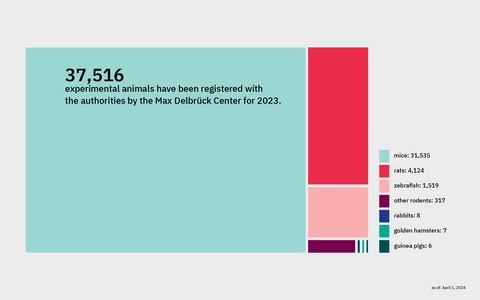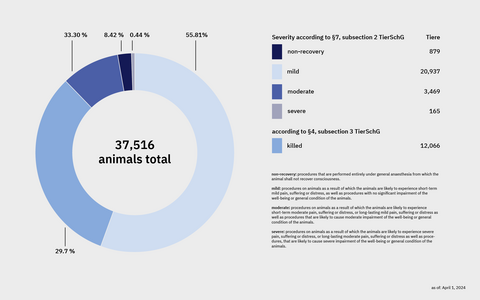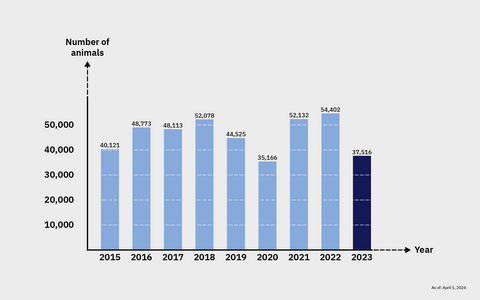
Facts and figures
Number of animals and type of experiments
Number of animals used for scientific purposes at the Max Delbrück Center
Research teams at the Max Delbrück Center and its partner institutions use mice, rats, and zebrafish in animal experiments. This includes animals used by individual research groups at Charité — Universitätsmedizin, the Leibniz Research Institute for Molecular Pharmacology (FMP), the Berlin Institute of Health at Charité (BIH), and the two spin-offs T-knife and Berlin Cures.
In addition, there is a small colony of naked mole rats, which also serve as models for research. In the statistics, these are listed under "Other rodents". The rabbits, guinea pigs and golden hamsters live at the Max Delbrück Center for the training of animal caretakers. They are given into private hands ("Labortierhilfe") at the end of the experiment.
At the Max Delbrück Center, genetically modified mice serve as models for Alzheimer’s disease or for tumor development. Rats are mainly used for cardiovascular research, and zebrafish as a model for common developmental disorders of the heart.
The Max Delbrück Center also investigates special biological abilities that animals possess but humans lack, in an effort to understand and learn from them. People who suffer a stroke, for example, usually suffer permanent damage due to the associated oxygen deprivation. Naked mole rats, however, can go for a long time without oxygen and suffer no damage at all. Zebrafish hearts, meanwhile, are able to repair themselves – which would be helpful for people suffering from heart disease.
- How many laboratory animals are used for research in Germany? And how many of these are used at the Max Delbrück Center?
According to the Federal Institute for Risk Assessment (BfR), approximately 1.34 million animals were used in applied and basic research in Germany in 2020. Of these, approximately 2.7 percent, or more precisely 35,166 animals, were used at the Max Delbrück Center in 2020, a year marked by the Corona pandemic.
All animals that have been used in a study or been born as the result of breeding efforts at the Max Delbrück Center are reported to the BfR each year.
- How many animal experiments are conducted at the Max Delbrück Center per year?
- Over the course of a year, a total of about 300 animal studies are performed at the Max Delbrück Center.
Over the course of one year, about 300 animal studies are conducted in parallel, typically involving about one hundred animals per study.
- How many animals are needed in one animal study?
- While one study may manage with five animals, another may require around one hundred. For a study to be meaningful, the number of animals must be calculated according to statistical criteria: sufficiently high to produce a statistically relevant result, but as low as possible to meet animal welfare standards.
The number of animals required for a single study is always determined by the research question and scientific criteria. The number of animals must be high enough to ensure the likelihood of a statistically relevant result. This is the only way to make sure the study has any predictive power. While one study may manage with five animals, another may require around one hundred. Because of the breeding, keeping and approval processes involved, animal studies require a lot of money and time. They are therefore always the last, never the first, choice for our researchers to find answers to their research questions.
Type of experiments according to severity categories
In addition to the number of experimental animals and information on the animal species used, the annual report to the LAGeSo, which is the authority responsible for the Max Delbrück Center, also includes information on the severity of the animal experiments. The categories of severity and how the experiments must be classified into these categories are laid down in Directive 2010/63/EU of the European Parliament and of the Council of 22 September 2010 on the protection of animals used for scientific purposes. We have listed the exact definitions here:
- Severity categories
- according to EU Directive 2010/63/EU
Non-recovery:
Procedures which are performed entirely under general anaesthesia from which the animal shall not recover consciousness.Mild:
Procedures on animals as a result of which the animals are likely to experience short-term mild pain, suffering or distress, as well as procedures with no significant impairment of the well-being or general condition of the animals.Moderate:
Procedures on animals as a result of which the animals are likely to experience short-term moderate pain, suffering or distress, or long-lasting mild pain, suffering or distress as well as procedures that are likely to cause moderate impairment of the well-being or general condition of the animals.Severe:
Procedures on animals as a result of which the animals are likely to experience severe pain, suffering or distress, or long-lasting moderate pain, suffering or distress as well as procedures, that are likely to cause severe impairment of the well-being or general condition of the animals.
What was the level of severity of the animal experiments at the Max Delbrück Center in 2022 and how many animals were used?
Most of the animal experiments at the Max Delbrück Center in 2023, only caused a minor distress to the animals (category: mild). Another large proportion of the animals reported by the Max Delbrück Center were killed for scientific purposes, for example to examine cell or tissue samples. They are included in the statistics under “Killed to examine cell or tissue samples”. The category "non-recovery" includes experiments conducted under general anesthesia, where the animal is killed under anesthesia.
A very small number of animals are used in experiments that involve severe stress. Here, however, our scientists are obliged to reduce the stress - if at all possible - by using painkillers. They must also weigh up the burden against the expected medical and scientific benefits. In principle, the 3-R rule (reduce, refine, replace) applies: This means that researchers must keep the number of experimental animals as low as possible, minimise pain and suffering and use alternative methods whenever possible.
Previous years
Research, animal experiments and the 3Rs
Why animal research?
Why we cannot yet avoid animal testing
Our laboratory animals
PRC Preclinical Research Center
The 3R principles
Research without animal experiments
Mini-organ, mathematical model or mouse?
Facts and figures
Approval and monitoring
Transparent communication




